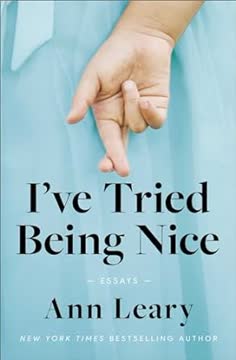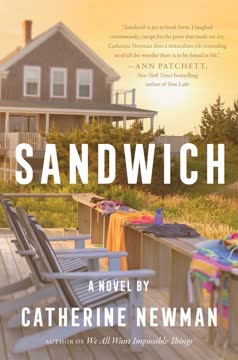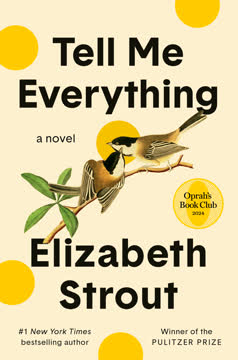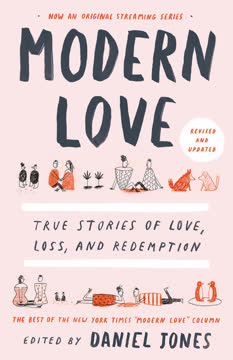Key Takeaways
1. The Unsympathetic Protagonist: Embracing Imperfection
And after that, I wrote novels, because in my case, it’s easier to create a likeable protagonist than to be one.
Self-Awareness is Key. The author's journey begins with the realization that she is not the most sympathetic character in her own life story. This self-awareness, born from feedback on her memoir, becomes a catalyst for exploring the complexities of human nature. It highlights the challenge of portraying oneself honestly, flaws and all, and the temptation to create more idealized versions of ourselves, especially in writing.
Authenticity over Likeability. The author's struggle with her own perceived lack of likeability leads her to create fictional characters, where she can control their traits and actions. This underscores the idea that authenticity, even with its imperfections, is more compelling than a forced attempt at likeability. It's a reminder that our flaws and struggles are what make us human and relatable.
The Power of Vulnerability. The author's journey is a testament to the power of vulnerability. By acknowledging her shortcomings, she invites readers to connect with her on a deeper level. This honesty, though initially uncomfortable, becomes a source of strength and allows her to explore the complexities of human experience with greater depth and nuance.
2. The Perils of People-Pleasing: A Quest for External Validation
It’s not that I needed everybody to like me. I needed them to love me. And not just my family and friends—I was the least nice to them. I needed the love and approval of complete strangers.
The Need for External Validation. The author's lifelong struggle with people-pleasing stems from a deep-seated need for external validation. This need is so strong that it extends beyond her inner circle to complete strangers, highlighting the often-unhealthy lengths we go to seek approval from others. This behavior is often rooted in insecurity and a lack of self-worth.
The Paradox of People-Pleasing. The author's attempts to be the "nicest person everybody ever met" often lead to confusion, misinterpretations, and even injuries. This paradox reveals the futility of trying to please everyone and the unintended consequences of prioritizing others' needs over one's own. It underscores the importance of setting boundaries and prioritizing self-respect.
The Cost of Inauthenticity. The author's people-pleasing tendencies are not just about being nice; they are about a deep-seated fear of angering others. This fear leads to inauthenticity and a constant need to monitor and adjust her behavior to fit others' expectations. It's a reminder that true connection comes from being genuine, not from trying to be what others want us to be.
3. Fame's Filter: Navigating Life in the Public Eye
“I’ve told you again and again. I’m fucking famous,” he grumbled. Then I remembered that he had mentioned it.
The Disconnect of Fame. The author's experience of her husband's fame highlights the disconnect between the public perception of a celebrity and the reality of their private life. Her initial confusion and awkward interactions with fans reveal the surreal nature of fame and the challenges of navigating a world where one's personal life is constantly under scrutiny.
The Translator Role. The author's tendency to repeat and translate fan interactions for her husband underscores the absurdity of fame and the way it can distort normal social interactions. This behavior, though well-intentioned, highlights the challenges of maintaining a sense of normalcy when one's life is constantly being observed and commented upon.
The Loss of Anonymity. The author's experiences with her husband's fans reveal the loss of anonymity that comes with fame. This loss of privacy can be disorienting and isolating, making it difficult to maintain a sense of self and navigate everyday life without being constantly recognized and judged.
4. The Menopausal Shift: Finding Freedom in Change
I didn’t know that one day I’d be simpering an apology to a stranger who’d spilled their coffee on me, and the next day I’d march out of my house, cast a cold-fish eye upon all creation and think: Fuck off.
Hormonal Influence on Behavior. The author's exploration of the ovary-brain connection highlights the profound impact of hormones on women's minds, bodies, and souls. This realization challenges the notion of a fixed personality and suggests that our behavior is often influenced by biological factors beyond our control.
The Liberation of Menopause. The author's experience of menopause is not just a physical change but a liberation from the need to please others. This shift, though initially jarring, allows her to embrace a more authentic and assertive version of herself. It's a reminder that change, even when unexpected, can be a catalyst for growth and self-discovery.
The "Cold-Fish Eye". The author's embrace of the "cold-fish eye" represents a rejection of the pressure to be constantly nice and agreeable. This newfound assertiveness allows her to set boundaries and prioritize her own needs, marking a significant shift in her approach to life and relationships.
5. The Coward's Dilemma: Confronting Fear and Finding Voice
I’m a coward. I’m terrified of making people angry. I have been all my life.
The Root of People-Pleasing. The author's realization that her people-pleasing tendencies stem from a deep-seated fear of angering others is a pivotal moment in her journey. This acknowledgment reveals the underlying anxiety that drives her behavior and highlights the need to confront her fears in order to live more authentically.
The Power of Directness. The author's confrontation with the "Doodle Lady" marks a turning point in her journey. By finally expressing her needs directly, she challenges her lifelong pattern of avoiding conflict and asserts her right to be heard. This act of courage, though initially uncomfortable, is a step towards greater self-respect and autonomy.
The Warning of "I've Tried Being Nice". The author's use of the phrase "I've tried being nice" as a warning is a powerful statement about the limits of politeness and the need to stand up for oneself. This phrase, like the cocking of a pistol, signals a shift from passive compliance to active assertion, highlighting the transformative power of finding one's voice.
6. The Self-Monitoring Trap: Fitting In vs. Being Authentic
When the results revealed that I’m a higher self-monitor than 90 percent of the test’s sample population, my self-esteem soared. Then I read that being a high self-monitor is a sign of low self-esteem.
The Illusion of Fitting In. The author's high score on the Self-Monitoring Scale initially boosts her self-esteem, but she soon learns that it's a sign of low self-esteem. This paradox reveals the trap of trying too hard to fit in and the underlying insecurity that drives this behavior. It's a reminder that true belonging comes from authenticity, not conformity.
The Impact of Childhood Mobility. The author's frequent moves during childhood contributed to her high self-monitoring tendencies. This constant need to adapt to new environments and social groups led her to become adept at mimicking others, but also made it difficult to develop a strong sense of self. It highlights the lasting impact of childhood experiences on adult behavior.
The Ant Farm Analogy. The author's analogy of the ant farm illustrates the disruption and chaos that comes with constant change. Each move is like shaking up the ant farm, scattering the ants and forcing them to rebuild their social structures from scratch. This analogy underscores the challenges of maintaining a sense of stability and belonging when one's environment is constantly changing.
7. The Nomad's Journey: Finding Home Within
Every time we moved, I could immediately identify the most popular, the biggest jock, the geeks, the nice kids, the bullies, and the most bullied.
The Upsides of Moving. Despite the challenges of constant relocation, the author acknowledges the benefits of her nomadic childhood. She learned early on that people everywhere are more alike than different, and she developed a keen ability to observe and understand social dynamics. This adaptability and awareness became valuable assets in her life.
The "Grass is Greener" Syndrome. The author's father's constant search for a better place to live highlights the "grass is greener" syndrome, a psychological pattern that involves a perpetual dissatisfaction with one's current circumstances. This pattern, often rooted in a fear of commitment, can lead to a cycle of constant change and a failure to find lasting contentment.
The Geographical Cure. The author's father's constant moves are likened to the "geographical cures" sought by addicts, highlighting the futility of trying to escape one's problems by changing locations. This analogy underscores the importance of addressing internal issues rather than seeking external solutions.
8. The Mother's Maze: Unraveling Family Legacies
When I stopped seeing my mother with the eyes of a child, I saw the woman who helped me give birth to myself.
The Planet Mom Myth. The author's childhood perception of her mother as a fully formed adult from "Planet Mom" highlights the tendency to view parents as static figures rather than complex individuals with their own histories and struggles. This myth is often shattered as we grow older and begin to see our parents as flawed and human.
The Power of Shared Stories. The author's quest to understand her mother's childhood reveals the importance of family stories in shaping our identities. By piecing together fragments of her mother's past, she gains a deeper understanding of her own life and the patterns that have been passed down through generations.
The Cycle of Trauma. The author's exploration of her mother's and grandmother's lives reveals a cycle of trauma and dysfunction that has been perpetuated through generations. This cycle, though painful, highlights the importance of breaking free from negative patterns and creating a healthier future for oneself and one's family.
9. The Bat in the Pajamas: Embracing the Absurd
“Mom, there’s a bat on your pajamas.”
The Unexpected Absurdity of Life. The author's encounter with a bat on her pajamas highlights the unexpected and absurd moments that often punctuate our lives. This incident, though initially frightening, becomes a source of humor and a reminder that life is often unpredictable and chaotic.
The Fear of the Unknown. The author's reaction to the bat reveals the primal fear of the unknown and the way it can trigger irrational responses. This fear, though often illogical, is a powerful force that can shape our behavior and our perceptions of the world.
The Symbiosis of Fear and Humor. The author's ability to find humor in her bat encounters underscores the way that fear and humor are often intertwined. By embracing the absurdity of life, we can find a way to cope with the challenges and anxieties that we face.
10. The Internet Persona: The Allure of the Virtual Self
On the internet, I’m friendly, thoughtful, and altruistic. I’m a doer, a go-getter, a fun-loving “people person” whose looks have held up relatively well for my age. In real life, I’m a borderline hermit who is slovenly, pessimistic, and wrinkled.
The Dichotomy of Online and Offline Selves. The author's description of her online persona as a "better" version of herself highlights the allure of the virtual world and the temptation to create idealized versions of ourselves online. This dichotomy reveals the gap between our curated online identities and the messy realities of our offline lives.
The Fascination with Online Frauds. The author's fascination with the online fraud "Jane" reveals the allure of deception and the way it can captivate our attention. This fascination, though initially framed as research, becomes a way for the author to explore her own insecurities and the complexities of human behavior.
The Intimacy of Virtual Connections. The author's experience with her online group highlights the surprising intimacy that can develop through virtual connections. These relationships, though initially based on a shared fascination with an online fraud, become a source of support and understanding, revealing the power of online communities to foster genuine human connection.
11. The Three-Drinks-Short Truth: Facing Addiction's Reality
After two or three drinks was precisely when I always started to feel in control. But how do you explain to a social drinker what it’s like to have been born three-drinks-short of comfortable? You can’t.
The Illusion of Control. The author's description of feeling "in control" after a few drinks highlights the deceptive nature of addiction and the way it can distort one's perception of reality. This illusion of control is a common experience for those struggling with substance abuse and underscores the need for self-awareness and honesty.
The "Three-Drinks-Short" Metaphor. The author's metaphor of being "three-drinks-short of comfortable" captures the underlying anxiety and discomfort that often drives addictive behaviors. This metaphor highlights the way that alcohol can be used as a coping mechanism to manage difficult emotions and feelings of inadequacy.
The Power of the Program. The author's return to the Program after a relapse underscores the importance of support and community in overcoming addiction. This journey highlights the need for ongoing self-reflection and the recognition that recovery is a lifelong process.
12. The Lifelong Learner: Finding Joy in New Skills
It turns out that learning new skills in midlife is a great way to feel young again.
The Value of Lifelong Learning. The author's embrace of new skills in midlife, from banjo lessons to tennis and EMT training, highlights the importance of lifelong learning and the way it can enrich our lives. This pursuit of knowledge and mastery is not just about acquiring new abilities but about maintaining a sense of curiosity and engagement with the world.
The Conscious Incompetence Stage. The author's experience with the Conscious Competence Learning Matrix reveals the challenges and rewards of learning new skills. The "Conscious Incompetence" stage, though often frustrating, is a necessary step on the path to mastery and a reminder that growth often involves discomfort and vulnerability.
The Therapeutic Power of Learning. The author's use of learning new skills as a way to cope with stress and creative blocks highlights the therapeutic power of engagement and the way it can provide a sense of purpose and accomplishment. This approach underscores the importance of finding activities that challenge us and bring us joy.
Last updated:
FAQ
1. What is "I've Tried Being Nice" by Ann Leary about?
- Personal Essays on Niceness: The book is a collection of humorous, candid essays exploring Ann Leary’s lifelong struggle with being a “people pleaser” and her journey toward setting boundaries.
- Themes of Self-Discovery: Leary reflects on her experiences with family, marriage, motherhood, aging, addiction, and social expectations, all through the lens of trying (and often failing) to be “nice.”
- Aging and Change: The essays chronicle how Leary’s attitudes toward niceness, confrontation, and self-worth evolve, especially as she enters midlife and beyond.
- Relatable Anecdotes: The book is filled with real-life stories—awkward encounters, family mishaps, and moments of self-realization—that many readers will find both funny and familiar.
2. Why should I read "I've Tried Being Nice" by Ann Leary?
- Witty and Honest Voice: Leary’s writing is sharp, self-deprecating, and laugh-out-loud funny, making even serious topics accessible and engaging.
- Universal Struggles: The book addresses common issues—people-pleasing, family dynamics, aging, and self-acceptance—that resonate with a wide audience.
- Insightful Reflections: Leary offers thoughtful observations on the costs and benefits of being “nice,” and how it shapes relationships and self-identity.
- Empowering Message: Readers are encouraged to reconsider the value of niceness, embrace imperfection, and find humor in life’s messiness.
3. What are the key takeaways from "I've Tried Being Nice" by Ann Leary?
- Niceness Has Limits: Being nice can be a strength, but it can also be a form of self-betrayal or avoidance of conflict.
- Boundaries Are Essential: Learning to say “no” and stand up for oneself is a crucial part of personal growth, especially for chronic people-pleasers.
- Aging Brings Clarity: Leary finds that menopause and aging help her care less about others’ opinions and more about her own needs.
- Humor as Survival: Finding the funny side of awkward, painful, or embarrassing moments is a powerful coping mechanism.
4. How does Ann Leary define and explore "niceness" in "I've Tried Being Nice"?
- People-Pleasing Roots: Leary describes her compulsion to be liked and approved of, often at her own expense, as a lifelong habit rooted in insecurity.
- Cultural and Gender Expectations: She examines how women, in particular, are socialized to be agreeable, accommodating, and self-sacrificing.
- Niceness vs. Authenticity: The book explores the tension between being nice and being honest, showing how forced niceness can lead to resentment or cowardice.
- Transformation Over Time: Leary’s essays chart her gradual shift from compulsive niceness to a more assertive, authentic way of interacting with the world.
5. What are some of the most memorable stories or anecdotes in "I've Tried Being Nice" by Ann Leary?
- The Doodle Lady Showdown: Leary’s escalating conflict with a neighbor who lets her dogs run loose becomes a metaphor for her struggle to assert boundaries.
- Bat on Pajamas Incident: A hilarious and horrifying account of discovering a bat clinging to her pajamas, illustrating family chaos and her own reactions to fear.
- Red Carpet Mishaps: Leary recounts awkward moments navigating Hollywood events as the wife of actor Denis Leary, including being mistaken for other celebrities’ spouses.
- Alcoholism and Recovery: She shares her journey with alcoholism, relapse, and returning to sobriety, highlighting the role of niceness and denial in addiction.
6. How does Ann Leary address aging and menopause in "I've Tried Being Nice"?
- Menopause as Liberation: Leary describes menopause as a turning point that frees her from the compulsion to be nice and care about others’ approval.
- Physical and Emotional Changes: She candidly discusses the effects of aging—gray hair, hearing loss, changing body image—and how they impact her self-perception.
- Letting Go of Perfection: Aging helps her accept her flaws, stop over-apologizing, and focus on what truly matters to her.
- Humor in Aging: Leary uses wit to deflate the anxieties and indignities of getting older, making the topic relatable and less intimidating.
7. What does "I've Tried Being Nice" by Ann Leary reveal about family, marriage, and motherhood?
- Complex Family Dynamics: Leary explores her relationships with her parents, siblings, and children, highlighting both love and tension.
- Marriage Realism: She offers an honest look at her long marriage to Denis Leary, including rough patches, therapy, and the role of competition and partnership.
- Mother-Daughter Relationships: The book delves into generational patterns, especially between mothers and daughters, and the impact of family history on self-image.
- Empty Nest Reflections: Leary shares the bittersweet transition to an empty nest, revealing both grief and newfound freedom.
8. How does Ann Leary discuss addiction and recovery in "I've Tried Being Nice"?
- Personal Struggle: Leary openly recounts her experiences with alcoholism, including denial, relapse, and the challenges of sobriety.
- Role of Niceness: She connects her people-pleasing tendencies to her drinking, noting how being “nice” often masked deeper issues.
- Twelve-Step Insights: The book provides a candid look at recovery programs, the stigma of addiction, and the importance of honesty and self-acceptance.
- Relapse and Return: Leary’s story includes a period of “controlled” drinking and the realization that true recovery required letting go of self-delusion.
9. What advice or life lessons does Ann Leary offer in "I've Tried Being Nice"?
- Set Boundaries: Don’t be afraid to say no or stand up for yourself, even if it feels uncomfortable.
- Embrace Imperfection: Accept that you can’t please everyone and that making mistakes is part of being human.
- Find Your Voice: Speak honestly, even if it risks disapproval, and prioritize authenticity over forced niceness.
- Laugh at Yourself: Use humor to navigate life’s challenges and to keep perspective on your own foibles.
10. What are some of the best quotes from "I've Tried Being Nice" by Ann Leary and what do they mean?
- “I’ve tried being nice…”: This phrase, used as a warning in a confrontation, encapsulates the moment Leary stops people-pleasing and asserts herself.
- “Being a people pleaser in the recovery, or any therapeutic world isn’t a compliment—it’s a character defect.”: Leary highlights how compulsive niceness can be self-destructive.
- “It’s not where the ball, or the child or the book or the marriage or the job, starts. It’s where it ends up that’s important.”: A tennis metaphor for focusing on outcomes and growth rather than initial appearances.
- “Kindness is selfless, it doesn’t come from a fear of rejection or a desire to be admired, it comes, in its purest form, from wanting, simply, to be good to others.”: Leary distinguishes genuine kindness from performative niceness.
11. How does Ann Leary use humor and self-deprecation in "I've Tried Being Nice"?
- Turning Flaws into Comedy: Leary mines her own awkwardness, mistakes, and anxieties for laughs, making her stories both entertaining and relatable.
- Deflating Social Pretensions: She pokes fun at celebrity culture, social niceties, and her own attempts to fit in, exposing the absurdity of many social rituals.
- Coping Mechanism: Humor is presented as a way to survive embarrassment, disappointment, and the messiness of life.
- Inviting Empathy: By not taking herself too seriously, Leary invites readers to be gentler with themselves and others.
12. What unique perspectives or methods does Ann Leary introduce in "I've Tried Being Nice" regarding self-improvement and personal growth?
- Conscious Incompetence Matrix: Leary references the “Four Stages of Learning” to describe the process of acquiring new skills and accepting one’s limitations.
- Learning Through Hobbies: She advocates for trying new things (banjo, tennis, EMT training) as a way to stay engaged and humble.
- Redefining Success: Leary suggests that growth comes not from perfection, but from persistence, self-awareness, and the willingness to laugh at setbacks.
- Letting Go of Performative Niceness: The book encourages readers to move beyond surface-level niceness and cultivate genuine kindness, self-respect, and resilience.
Review Summary
I've Tried Being Nice is a collection of humorous and relatable essays by Ann Leary. Readers found the book entertaining, with many laughing out loud at Leary's anecdotes about marriage, family, and everyday life. Some appreciated her honesty about struggles with anxiety and alcoholism. While a few felt the essays lacked depth or cohesion, most enjoyed Leary's wit and self-deprecating humor. The book resonated particularly well with readers in their 50s and those who struggle with people-pleasing tendencies.
Similar Books
Download PDF
Download EPUB
.epub digital book format is ideal for reading ebooks on phones, tablets, and e-readers.












